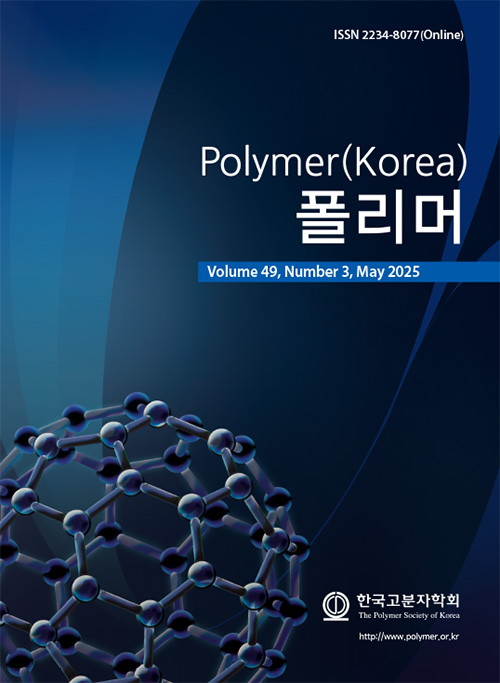- Effect of Surface Modification of Cellulose Nanofibers (CNFs) with Silane on the Properties of Rigid Polyurethane Foam (RPUF)
Department of Chemical Engineering, Kyonggi University, 154-42, Gwanggyosan-ro, Yeongtong-gu, Suwon 16227, Korea
- 실란으로 표면 개질된 셀룰로오스 나노섬유가 경질 폴리우레탄 폼의 물성에 미치는 영향
경기대학교 화학공학과
Reproduction, stored in a retrieval system, or transmitted in any form of any part of this publication is permitted only by written permission from the Polymer Society of Korea.
In this study, to improve the properties of rigid polyurethane foam (RPUF), highly hydrophilic cellulose nanofiber (CNF) was modified using different silanes with mercapto, amine, and epoxy functional groups, and subsequently used as additives for RPUF. The effects of modified CNFs (Si-CNF) on the properties of Si-CNF/PU composite foams were investigated through scanning electron microscope (SEM), universal testing machine (UTM), and thermal conductivity analysis. The results confirmed that the use of Si-CNF enhanced the mechanical properties of the composites due to improved compatibility with PU. Notably, the addition of CNFs modified with amino silane resulted in a 7.5% improvement in thermal insulation performance and a 17% increase in compressive strength, compared to conventional RPUF.
경질 폴리우레탄 폼(rigid polyurethane foam, RPUF)의 물성 향상을 위해 높은 친수성의 cellulose nanofiber(CNF)를 머캅토, 아민, 에폭시 작용기를 가진 서로 다른 실란을 사용하여 표면 개질한 후 RPUF의 첨가제로 사용하였다. 실란으로 개질된 CNF(Si-CNF)가 Si-CNF/PU 복합 발포체의 물성에 미치는 영향을 scanning electron microscope(SEM), universal testing machine(UTM), 열전도도 분석을 통해 고찰하였다. 그 결과, Si-CNF를 사용할 경우 PU와의 상용성 향상으로 인해 기계적 물성이 향상됨을 확인하였다. 특히 아미노 실란으로 개질된 CNF를 첨가하였을 경우 기존 RPUF에 비해 단열 성능과 압축강도가 각각 7.5%, 17% 향상되었다.
Keywords: silane, cellulose nanofiber, rigid polyurethane foam, thermal conductivity, nucleant.
- Polymer(Korea) 폴리머
- Frequency : Bimonthly(odd)
ISSN 2234-8077(Online)
Abbr. Polym. Korea - 2024 Impact Factor : 0.6
- Indexed in SCIE
 This Article
This Article
-
2025; 49(3): 350-358
Published online May 25, 2025
- 10.7317/pk.2025.49.3.350
- Received on Dec 11, 2024
- Revised on Jan 2, 2025
- Accepted on Jan 2, 2025
 Correspondence to
Correspondence to
- Sangbum Kim
-
Department of Chemical Engineering, Kyonggi University, 154-42, Gwanggyosan-ro, Yeongtong-gu, Suwon 16227, Korea
- E-mail: ksb@kyonggi.ac.kr









 Copyright(c) The Polymer Society of Korea. All right reserved.
Copyright(c) The Polymer Society of Korea. All right reserved.